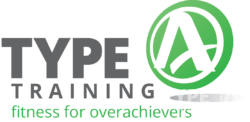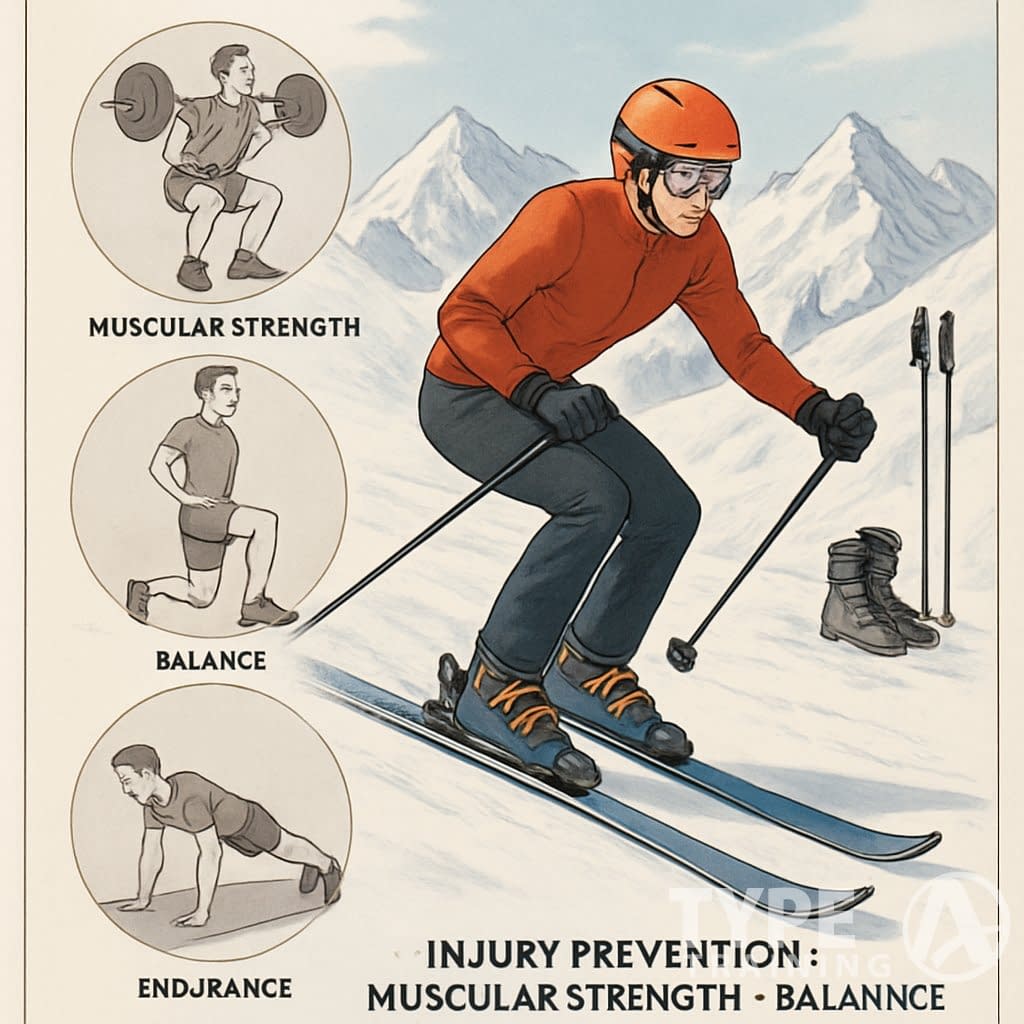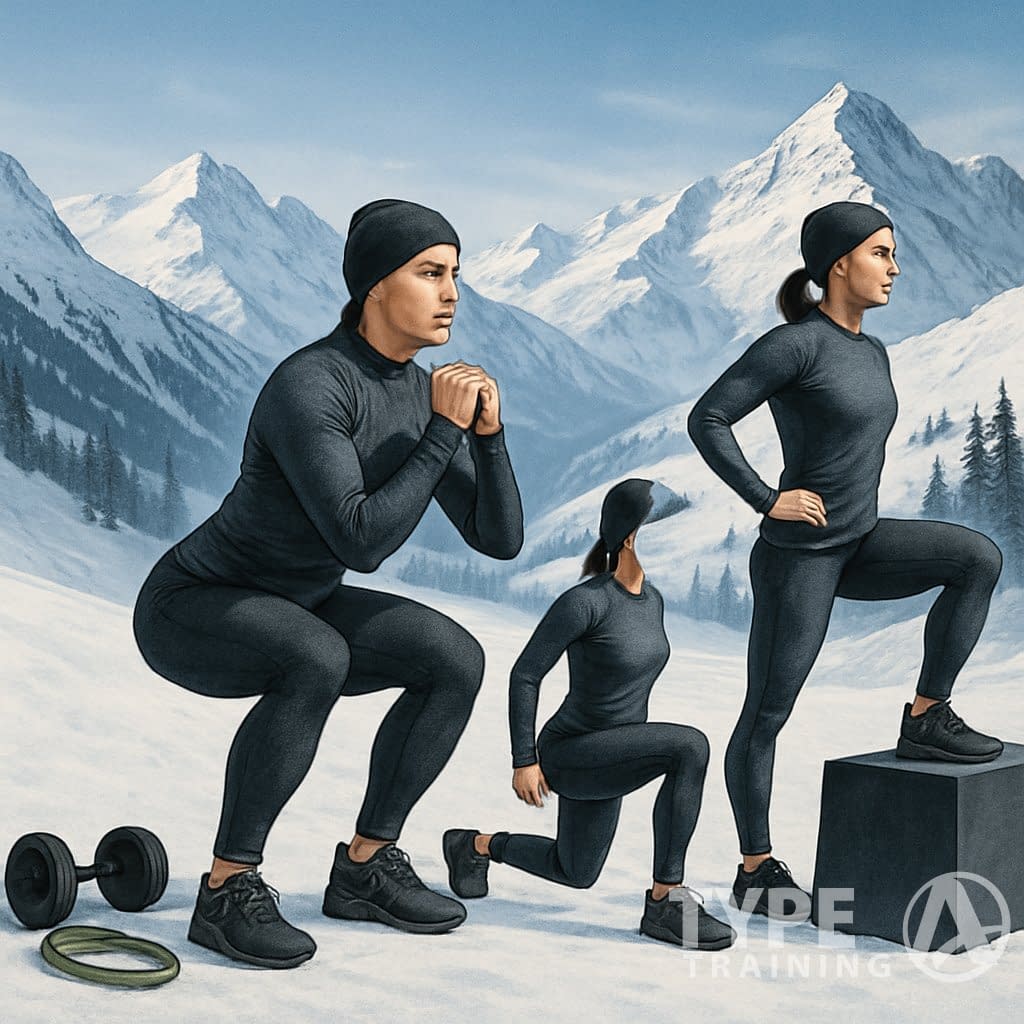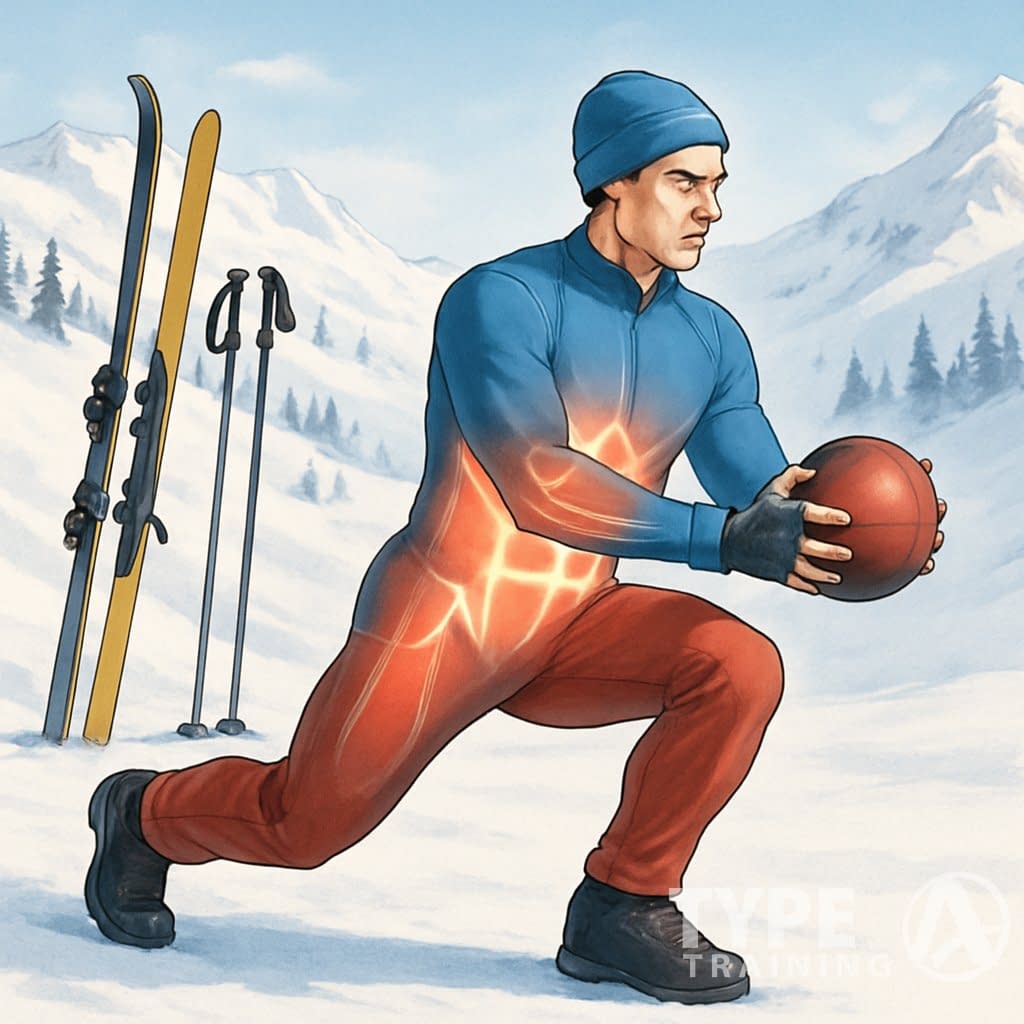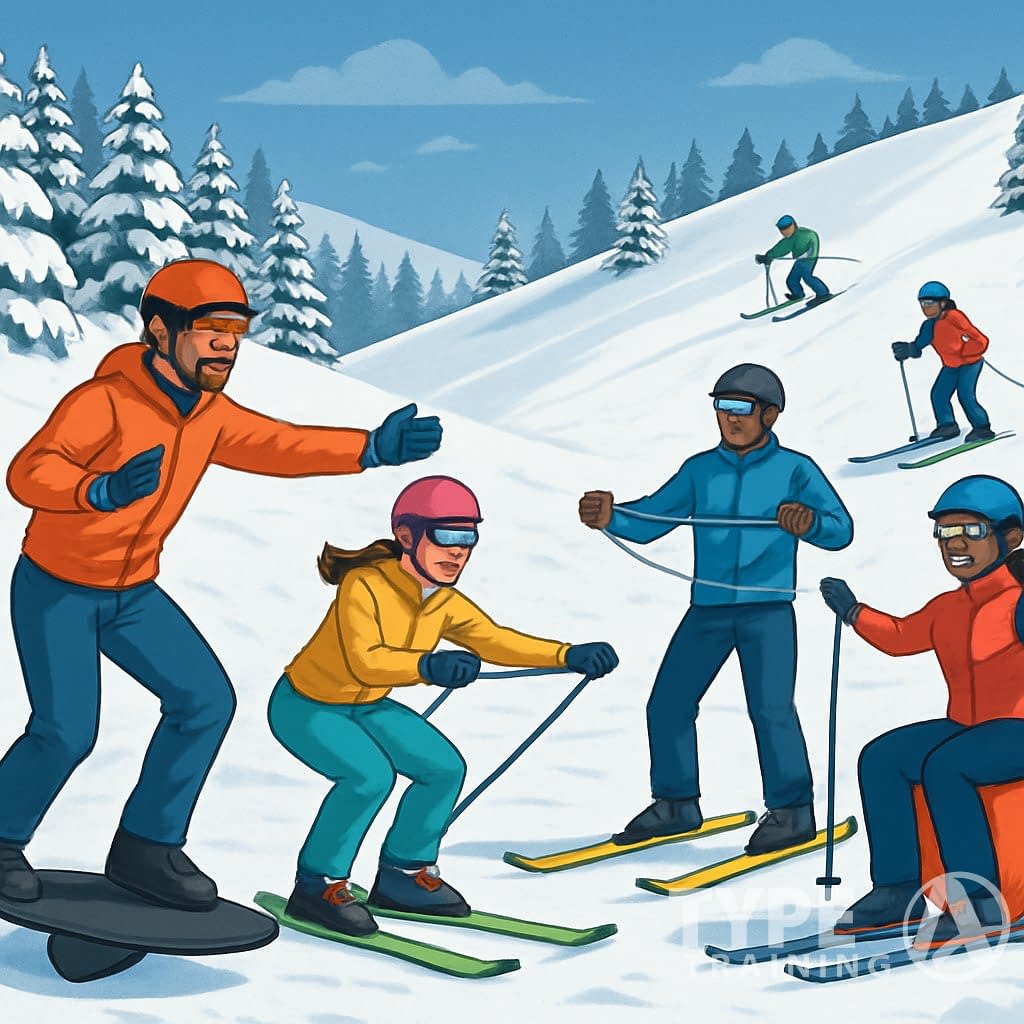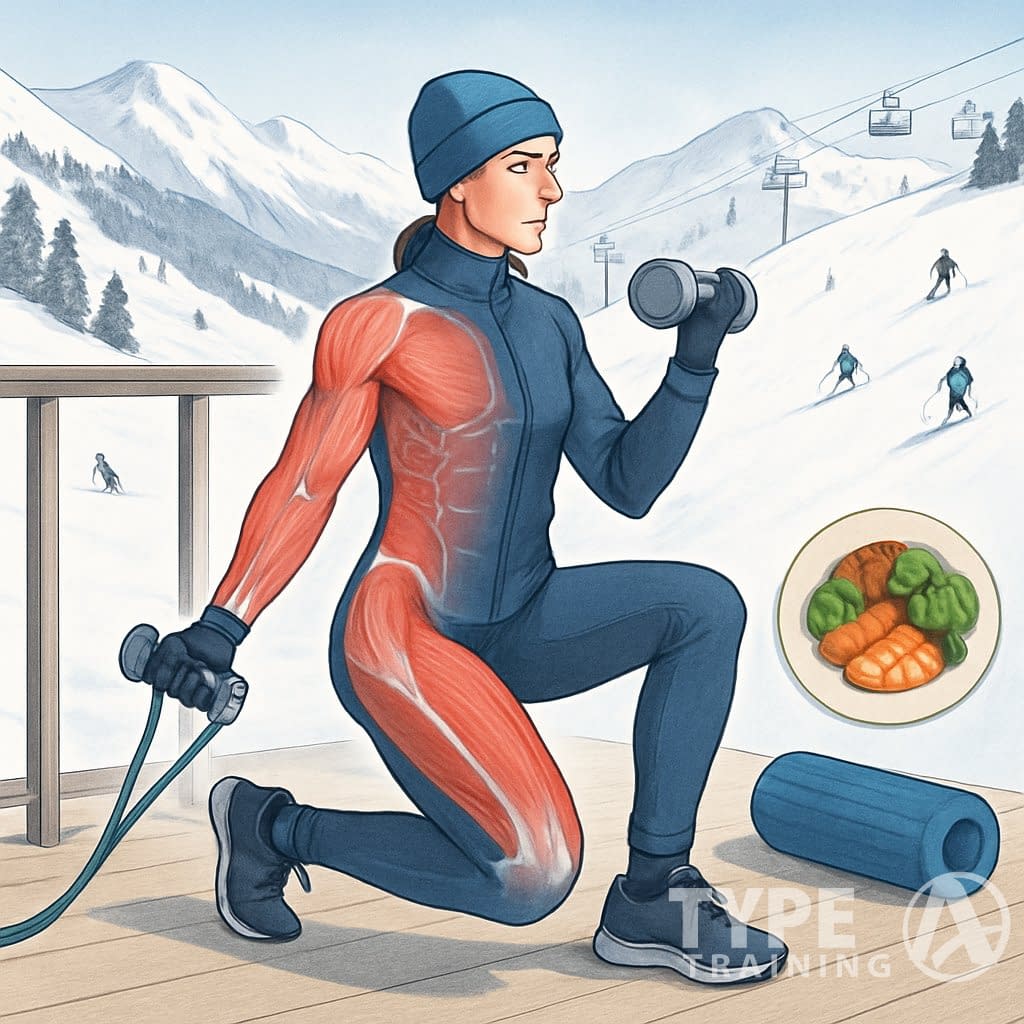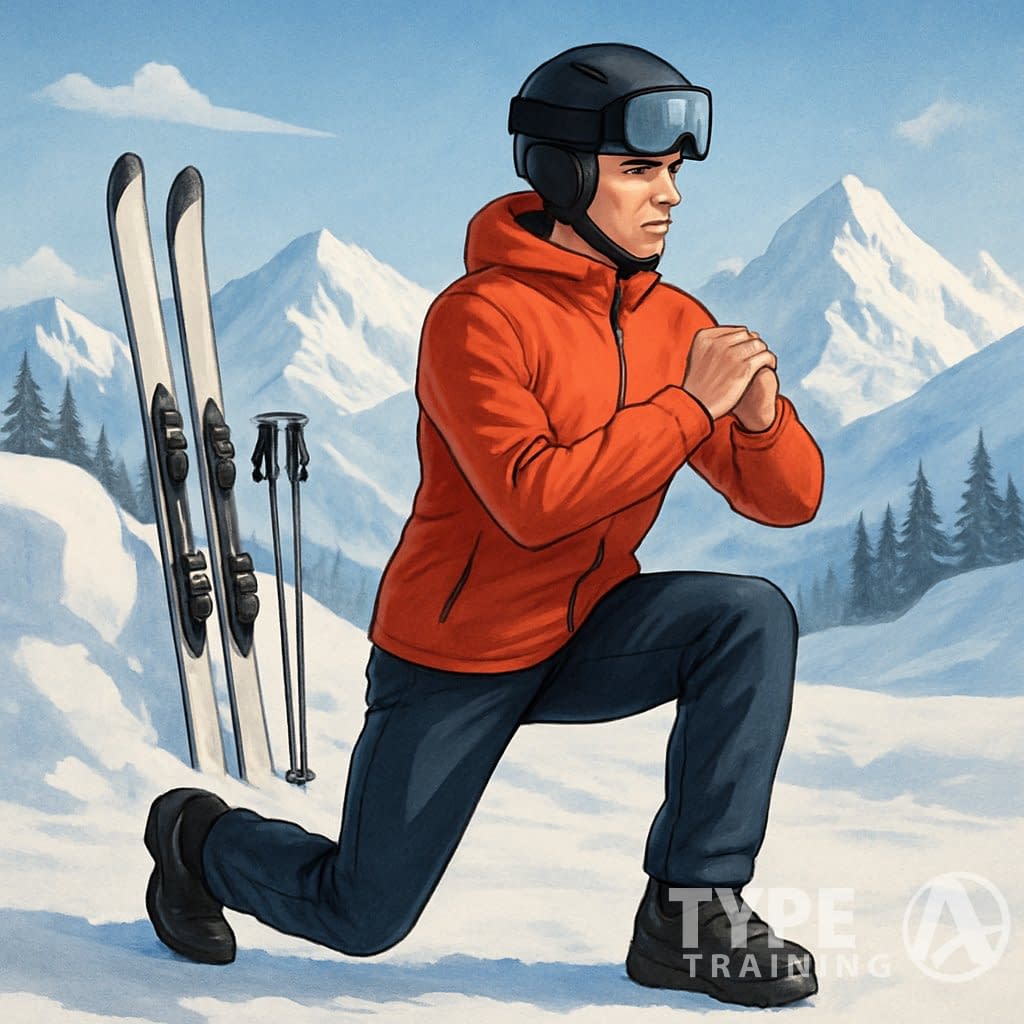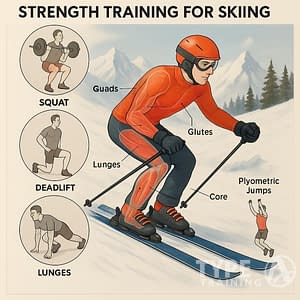Ski season brings a rush of excitement and adventure. But let’s be honest, it can also sideline you with injuries if your body’s not up for the challenge.
Don’t let injuries ruin your ski trip by ensuring your body is ready for the slopes.
Every year, thousands of skiers find themselves in medical clinics with torn ligaments, muscle strains, and other injuries that are often preventable. The right kind of training could make all the difference.
It’s crucial to remember: don’t let injuries ruin your ski trip. Proper training is key to prevention.
Popular posts:
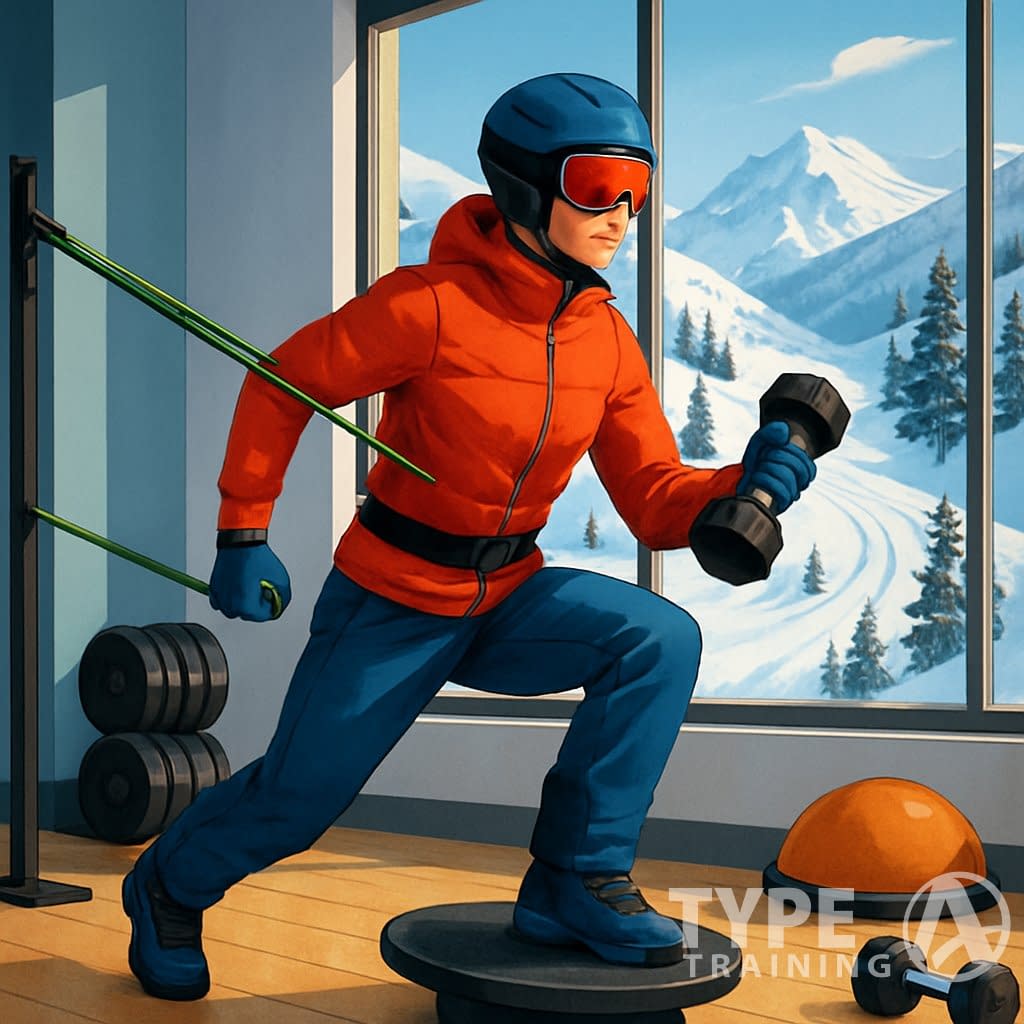
Building strength, balance, and endurance with targeted exercises before you hit the slopes cuts your injury risk and boosts your skiing performance. Your legs, core, and stabilizing muscles need to handle some wild forces and quick direction changes out there.
When you prepare, you actively choose to don’t let injuries ruin your ski trip.
If you skip the prep, your muscles tire out fast and stop protecting your joints. That’s when things go wrong.
Don’t let injuries ruin your ski trip; staying active is essential.
Smart training doesn’t have to mean months at the gym or fancy equipment. The right moves get your body ready for ski season’s physical demands.
To ensure you don’t let injuries ruin your ski trip, engage in smart training routines.
Plus, you’ll enjoy longer days on the mountain with less fatigue and better control. Isn’t that the dream?
Key Takeaways
Don’t Let Injuries Ruin Your Ski Trip
Remember, don’t let injuries ruin your ski trip—train smart!
- Strength training before ski season slashes injury risk and sharpens your performance on the slopes.
- Zero in on lower body power, core stability, and balance exercises that mimic skiing.
- Begin your training program a few weeks before your trip and don’t skimp on recovery.
Why Strength Training Matters for Injury Prevention
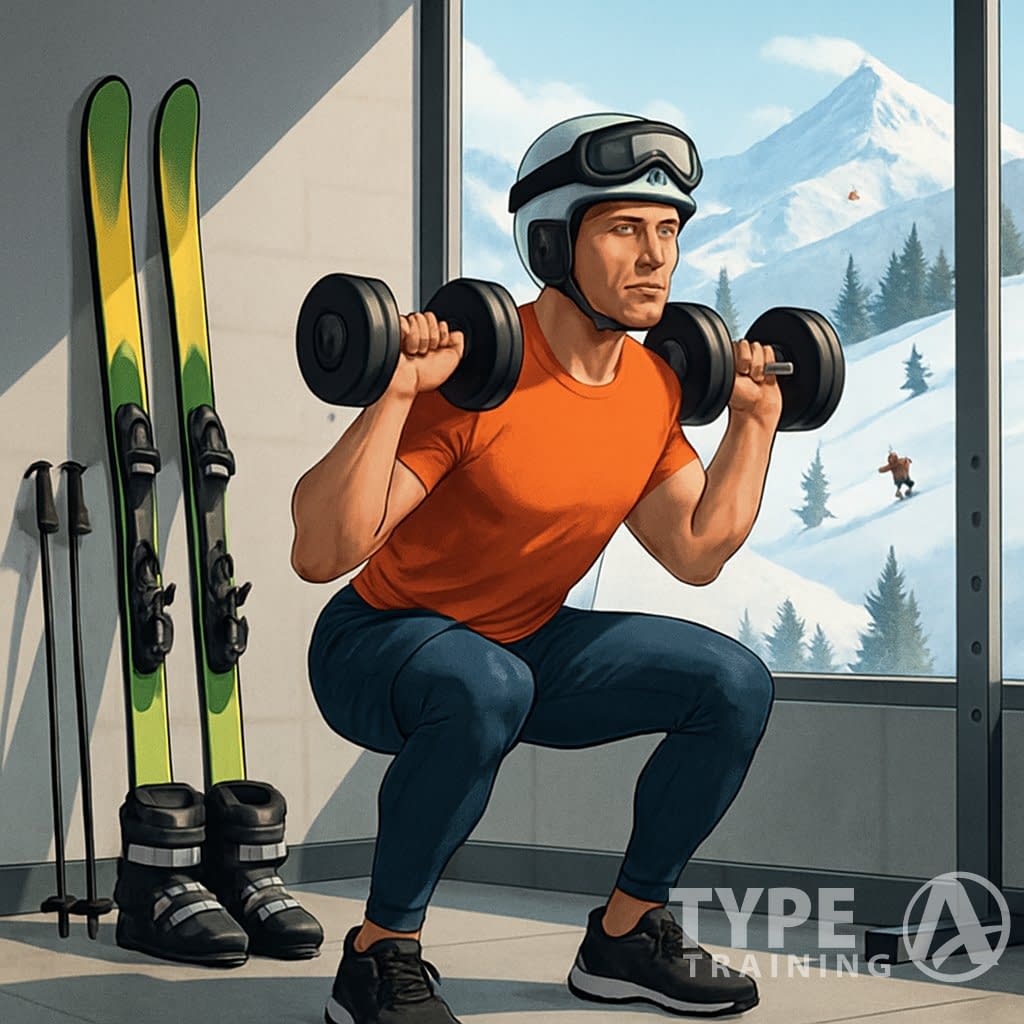
Research shows strength training can cut sports injuries by nearly half. Strong muscles protect your joints, improve balance, and help you manage the physical grind of skiing.
Don’t let injuries ruin your ski trip by focusing on strength building.
Common Skiing Injuries and Their Causes
Skiing puts unique stress on your body. Your knees, in particular, take a beating since they absorb impact and steer your movements.
Understanding your body’s limitations helps you don’t let injuries ruin your ski trip.
ACL tears are a real threat when you twist or land awkwardly. These knee injuries often show up when your ski catches an edge or you fall backward.
MCL sprains usually happen from side-to-side forces on your knee. Crossed ski tips or catching an inside edge can do it.
Ankle sprains pop up when your boots don’t support you enough. Hard landings or quick direction changes can roll your ankle.
Lower back pain is common from the bent-forward ski stance. Weak core muscles just make it worse.
Shoulder injuries tend to happen during falls, especially if you try to break your fall with your hands. Rotator cuffs are especially at risk.
Most of these injuries have similar roots. Muscle fatigue kills your control and form. Weak stabilizers can’t protect your joints. Bad balance leads to falls and ugly landings.
How Strength Training Reduces Injury Risk
Strength training makes your body tougher and more resilient for skiing. Your muscles, tendons, and bones all get stronger and more stable.
Incorporate strategies that ensure you don’t let injuries ruin your ski trip.
Joint stability gets a big boost when muscles around your joints are strong. Knee, ankle, and hip muscles work together to keep you upright and balanced. This teamwork helps you avoid awkward positions that cause injuries.
Better muscle balance matters too. Skiing overuses some muscles, which throws things off. Strength training targets those weaker spots to even things out.
Stronger bones can take more impact. Weight-bearing exercises build up bone density and help prevent stress fractures.
Improved reaction time comes from stronger, more coordinated muscles. You’ll recover from slips and stumbles faster, maybe dodging disaster altogether.
Stronger muscles don’t tire out as quickly. You keep your form longer during those endless ski days. Good form is your best defense against injury.
Good form is your best way to ensure you don’t let injuries ruin your ski trip.
Impact on Knee Pain and Knee Injury Prevention
Your knees deserve special attention—they’re the most commonly injured body part in skiing. Knee injuries make up about 30% of all skiing accidents. Yikes.
Quadriceps strength is huge for knee protection. Strong quads control your knee position and soak up landing forces. Weak quads dump extra stress onto your ACL and other ligaments.
Hamstring balance is key too. Lots of skiers have strong quads but weak hamstrings, and that imbalance can hike your ACL injury risk by as much as 70%.
With strong glutes, you can actively choose to don’t let injuries ruin your ski trip.
Glute strength takes pressure off your knees. Strong glutes control your hip position and help your knees track straight. Weak glutes let your knees cave in—never good.
Try these for knee protection:
-
- Squats and lunges for leg strength
- Single-leg moves for balance and stability
- Hamstring curls to balance out your quads
- Glute bridges for hip stability
Don’t let injuries ruin your ski trip by practicing these essential exercises.
Knee pain prevention also needs flexibility work. Tight muscles tug on your knee joint and cause pain. Pair strength training with stretching for the best results.
Strong legs can cut impact forces on your knees by up to 25%. That protection becomes even more important on tougher terrain or longer ski days.
Fundamental Principles of Strength Training for Skiing
Effective ski strength training targets the muscle groups that control your movements on the mountain. You’ll want to adjust the timing and intensity of your training as ski season approaches.
Training preparation helps ensure you don’t let injuries ruin your ski trip.
Key Muscle Groups for Slope Performance
Your legs are the base for skiing strength. Build power in your quads, hamstrings, and glutes. These muscles steer your turns and cushion your landings.
Focus on building strength so you don’t let injuries ruin your ski trip.
Primary Lower Body Muscles:
- Quadriceps (front thigh)
- Hamstrings (back thigh)
- Glutes (buttocks)
- Calves
Your core keeps you balanced on uneven slopes. Strong abs and back muscles help you stay upright when you hit bumps or icy patches.
Stabilizers in your hips and ankles prevent injury. These smaller muscles are always working while you ski. Train them with single-leg and balance exercises.
Don’t ignore your upper body. Arms and shoulders help with pole plants and balance—and they’re your last line of defense in a fall.
Pre-Season vs. In-Season Preparation
Start prepping 8-12 weeks before your first ski trip. Focus on building strength and muscle size early on. Go heavy with fewer reps.
Pre-Season Focus (8-12 weeks out):
- Heavy strength training 3-4 times a week
- High weights, low reps (3-5 per set)
- Build muscle mass and power
Once ski season starts, shift to maintenance mode. Cut back to 1-2 gym sessions a week. Keep it intense but trim the volume.
In-Season Focus:
Plan your training thoughtfully to ensure you don’t let injuries ruin your ski trip.
- Light strength work 1-2 times weekly
- Moderate weights, 6-10 reps
- Maintain strength and prevent injury
Your body needs time to recover between ski days. Skip heavy leg workouts right before you hit the slopes.
Training Frequency and Progression
Start with 2-3 strength sessions per week in the pre-season. Rest at least a day between workouts. Muscles need that time to rebuild.
New to strength training? Begin with bodyweight exercises. Nail your form before adding weight—bad form just invites injuries.
Working on your form will help you don’t let injuries ruin your ski trip.
Sample Weekly Schedule:
- Monday: Lower body strength
- Wednesday: Upper body and core
- Friday: Full body or ski-specific drills
Each week, bump up weight or reps by 5-10% if things feel too easy. Keep a simple workout log to track your progress.
About 2-3 weeks before ski season, stop ramping up the intensity. Focus on moving well instead of lifting heavier.
Essential Lower Body Strength Exercises
Engaging in effective exercises means you won’t let injuries ruin your ski trip.
Building powerful legs and strong stabilizers is crucial for safe skiing and protecting your knees. These four exercise categories will get your lower body ready for the slopes.
Squats and Variations for Power
Squats are the cornerstone of ski strength. They build the quad and glute power you need for turns and soaking up bumps.
Start with bodyweight squats to dial in your form. Feet shoulder-width apart, lower down until your thighs are parallel to the floor. Your knees should track over your toes—don’t let them cave in.
Jump squats add explosive power. Squat down, then explode upward and land soft. This move is pretty close to what your legs do on the mountain.
Wall sits give you isometric strength so you can hold ski positions longer. Lean against a wall, thighs parallel to the ground, and hold for 30-60 seconds. It burns, but it works.
Goblet squats with a dumbbell add resistance and fire up your core. A nice twist on the classic squat.
Lunges and Split Squats for Stability
Incorporating lunges into your routine is essential to ensure you don’t let injuries ruin your ski trip.
Lunges train your legs to work one at a time and build the stabilizers around your knees. That’s huge for avoiding injuries on uneven terrain.
Forward lunges teach you to control your weight as you move. Take a big step forward, lower your back knee, and push through your front heel to stand up.
Lateral lunges are especially good for skiing. They strengthen the muscles that move you side to side—just like carving a turn.
Split squats with your back foot up on a bench are a real challenge. They mimic the skiing stance and light up all the right muscles.
Mix in lunges in all directions—forward, backward, sideways—to hit different stabilizers. Variety is your friend.
Unilateral Training for Balance and Injury Prevention
Single-leg exercises are a must if you want to avoid ski injuries. They correct strength imbalances and boost your balance for those unpredictable snow conditions.
Single-leg exercises are crucial if you want to ensure you don’t let injuries ruin your ski trip.
Single-leg Romanian deadlifts target your hamstrings and glutes while forcing you to balance. Stand on one leg, hinge at the hip, and reach toward the floor.
Single-leg squats are tough. If they’re too hard, try squatting to a chair on one leg. It’s still effective and easier to manage.
Single-leg glute bridges fire up your glutes and teach your hips to move right. Lie on your back, one foot planted, the other leg straight out.
These moves make your stabilizers work overtime. That’s exactly what you need for the unpredictable forces of skiing.
Deadlifts and Posterior Chain Strength
Deadlifts build strength in your hamstrings, glutes, and lower back. This kind of posterior chain power helps you keep good posture and control when you’re skiing.
Strong posterior chain muscles also help you don’t let injuries ruin your ski trip.
Romanian deadlifts really hit your hamstrings and glutes. Just grab a barbell or dumbbells, hinge at your hips, and keep your back straight.
Sumo deadlifts use a wide stance to target your inner thighs and glutes. It’s a solid way to mimic that wide skiing stance.
Try good mornings with a light weight across your shoulders. Bend at the hips, keep your back flat, and stand back up—your lower back will thank you.
Strong posterior chain muscles protect your knees by controlling leg movement. Plus, they give you the power you need to drive through each turn.
Core and Upper Body Strategies for the Slopes
Core strength is key to ensuring you don’t let injuries ruin your ski trip.
Your core and upper body work together for balance and control out on the slopes. You need strong rotational movements, stable shoulders, and protected wrists to ski safely and well.
Rotational and Anti-Rotational Core Movements
Skiing constantly challenges your core stability. You have to resist unwanted twisting while still moving with control.
Anti-rotational exercises build that stability:
- Pallof press: Hold a resistance band at chest height and press it straight out
- Dead bug: Lie on your back, extend opposite arm and leg
- Bird dog: On hands and knees, reach out opposite arm and leg
Rotational movements help you generate turning power:
- Russian twists: Sit with feet up and rotate your torso side to side
- Medicine ball slams: Throw the ball diagonally across your body
- Cable wood chops: Pull the cable from high to low in a chopping motion
Try these exercises 3-4 times a week. Three sets of 10-15 reps per move is a good place to start.
Your core connects your upper and lower body every time you turn. If your core is weak, other muscles have to pick up the slack, which can lead to injury.
Upper Body Strength for Ski Control
Your arms and shoulders help you balance and control your body as you ski. Strong upper body muscles let you keep good form and recover from tough situations.
Strong upper body strength is vital so you don’t let injuries ruin your ski trip.
Key upper body exercises for skiing:
- Pull-ups or lat pulldowns: Build back strength for pole planting
- Push-ups: Strengthen your chest and shoulders for stability
- Shoulder external rotations: Use resistance bands to work your rotator cuffs
Functional movements that mimic what you do on skis:
- Plank with arm reaches: Hold a plank, reach one arm forward
- Single-arm rows: Pull a weight to your chest while bent over
- Overhead press: Press weights overhead to build shoulder stability
Train your upper body 2-3 times a week. It’s better to focus on good form and control than on lifting heavy.
Strong arms help you use your ski poles effectively. They also give you extra balance when you hit bumps or rough snow.
Injury Prevention for Shoulders and Wrists
Shoulder and wrist injuries are pretty common in skiing. Falls and pole impacts put a lot of stress on these joints during a day on the mountain.
Shoulder protection strategies:
- Strengthen your rotator cuffs with band exercises
- Practice controlled arm movements during workouts
- Warm up shoulders before skiing with arm circles and stretches
Wrist injury prevention:
Effective training can help you don’t let injuries ruin your ski trip.
- Skip the wrist straps on your ski poles
- Build forearm strength with wrist curls and grip work
- Learn how to fall properly so you don’t catch yourself with your hands
Common injury scenarios to watch out for:
- Falling forward and hyperextending your wrists
- Poles catching and twisting your shoulders
- Quick direction changes that strain your arms
Work on mobility for both shoulders and wrists. Gentle stretching and some movement prep can really lower your injury risk.
Practice letting go of your poles if you fall during training. It’s a simple habit, but it can prevent a lot of wrist and thumb injuries.
Remember to practice strategies so you don’t let injuries ruin your ski trip.
Training Balance and Coordination for Slope Safety
Good balance and coordination keep you in control on the slopes. Strong stabilizing muscles help prevent falls and lower your risk of injury.
Balance Drills to Mimic Skiing Movements
Start with single-leg stands to build ski balance. Stand on one foot for 30 seconds, then switch. Make it harder by closing your eyes or using an uneven surface.
Bosu ball exercises get you ready for unstable snow. Stand on the dome with both feet and shift your weight side to side—kind of like making turns.
Lateral hops help you practice skiing movements. Jump side to side on one foot and land softly. This works the muscles you need for shifting between edges.
Warrior III pose from yoga is great for your core and legs. Stand on one leg, extend the other behind you, and reach your arms out for balance.
Try these drills three times a week. Start with 30 seconds per exercise and work up to a minute.
Coordination Exercises for Responsive Control
Balance and coordination are key to ensuring you don’t let injuries ruin your ski trip.
Ladder drills boost your foot speed and timing. Step quickly through each square, switching up the patterns. Go for two feet in each box, then try single-foot hops.
Reaction ball drills sharpen your reflexes. Toss the odd-shaped ball at a wall and catch it as it bounces back in weird directions.
Cross-body moves train your upper and lower body to work together. Touch your right hand to your left knee while you balance on your right foot.
Try throwing and catching a ball while standing on one foot. It forces your brain to balance and multitask at the same time.
Medicine ball rotations help with core coordination. Hold a light ball and rotate your torso left and right, keeping your hips steady.
Improving Stabilizing Muscles for Injury Reduction
Your stabilizing muscles act like shock absorbers when you ski. These small, deep muscles keep your joints steady through bumps and quick turns.
Your stabilizing muscles help you don’t let injuries ruin your ski trip.
Planks target your core stabilizers. Hold a plank for 30-60 seconds. Add side planks to hit the muscles that stop sideways movement.
Glute bridges wake up your hip stabilizers and protect your knees. Lie on your back, lift your hips, and hold for a couple seconds before lowering.
Do calf raises on one foot for ankle stability. Rise onto your toes, then lower slowly. Your ankles need to be strong for uneven ground.
Hip abduction exercises work the outer hips. Lie on your side and lift your top leg up and down. These muscles help prevent knee injuries when you ski.
Try to do stabilizing exercises every day during ski season. Focus on slow, controlled moves—not speed.
Injury-Smart Workout Planning and Recovery
Smart training means knowing when to push and when to ease off. Your body needs the right mix of work, rest, and recovery to stay strong all ski season.
Plan your training to ensure you don’t let injuries ruin your ski trip.
Recognizing Symptoms of Overtraining
Your body will send up flares if you push too hard. Watch for these warning signs that you need to back off.
Physical warning signs include:
- Muscle soreness that sticks around for more than 48 hours
- Performance dropping in your usual workouts
- Resting heart rate higher than normal in the morning
- Trouble sleeping or staying asleep
Mental and emotional signs can show up as:
- Not wanting to train
- Feeling irritable or just off
- Struggling to focus during workouts
- Dreading your exercise sessions
If you notice these symptoms, cut your training intensity by 30-50% for a few days. Try light movement like walking or easy stretching instead of heavy lifting.
It helps to track your sleep, energy, and workouts in a simple log. That way, you can spot patterns before overtraining sneaks up on you.
Incorporating Mobility and Flexibility Work
Mobility work keeps your joints moving freely and your muscles ready to go. Spend 10-15 minutes on mobility before every strength session.
Prioritize mobility work to ensure you don’t let injuries ruin your ski trip.
Key areas to target are:
- Hip flexors and glutes
- Ankles and calves
- Shoulders and upper back
- Spinal rotation
Dynamic warm-ups work best before you train:
- Leg swings front to back
- Walking lunges with a twist
- Arm circles and shoulder rolls
- Hip circles both ways
After your workout, do static stretches for 30-60 seconds each. Focus on the muscles you just worked. It helps with stiffness and recovery.
Try a full mobility session 2-3 times a week on rest days. Foam rolling or using massage balls can loosen up tight spots from training.
Rest, Recovery, and Managing Knee Pain
Recovery days are crucial; otherwise, you might let injuries ruin your ski trip.
Recovery days matter just as much as training days if you want to get stronger. Your muscles grow and repair when you rest, not when you’re working out.
Plan your rest days wisely:
- Take 1-2 full rest days each week
- Alternate hard and easy training days
- Get 7-9 hours of sleep a night
- Drink plenty of water
Knee pain pops up a lot in ski training. Deal with it early so it doesn’t ruin your season.
Address any pain so you don’t let injuries ruin your ski trip.
Stop any exercise that causes sharp or shooting pain in your knees. Switch to low-impact stuff like swimming or cycling until the pain goes away.
If your knees feel sore or swollen after training, ice them for 15-20 minutes. Gentle walking helps reduce stiffness more than just sitting still.
See a doctor or physical therapist if knee pain hangs around for more than a few days or gets worse when you move.
Frequently Asked Questions
Preventive training can help you don’t let injuries ruin your ski trip.
Skiers always have questions about strength training, injury prevention, and how to stay safe—especially as they get older. Most people want practical advice, exercises that really work, and tips for preparing for the slopes without overcomplicating things.
What are the most effective strength training exercises to prevent ski-related injuries?
Lunges in all directions are awesome for single-leg strength. Forward, backward, and lateral lunges hit your quads, glutes, and hamstrings.
Squats lay the groundwork for strong skiing movements. Single-leg squats push your balance and stability while working each leg on its own.
Deadlifts build up your posterior chain muscles. These muscles help you keep good skiing posture and handle impacts from bumps or jumps.
Plyometric moves give you explosive power. Box jumps and lateral bounds get your muscles ready for quick changes in direction out there.
How can skiers prepare their bodies to minimize the risk of injury on the slopes?
Injury prevention should be a priority so that you don’t let injuries ruin your ski trip.
Start training at least 6-8 weeks before your trip. Your muscles need time to adapt and get stronger bit by bit.
Cardio matters more than some people think. Good cardiovascular fitness lets you ski longer, so you don’t tire out and make mistakes.
Work on flexibility and mobility every day. Tight muscles make you more likely to get hurt when you have to move fast on the slopes.
Balance exercises on unstable surfaces help a ton. Grab a balance board or foam pad and practice to boost your stability and reaction speed.
What core strengthening workouts are recommended for skiers to enhance stability and control?
Plank variations hit your core from different angles. Try standard planks, side planks, and planks with arm reaches to build up core strength.
Russian twists are great for your obliques. You need those muscles for turning and staying balanced.
Dead bugs teach your core to stay stable while your limbs move. This coordination is exactly what you need when you’re skiing.
Coordinated training strategies ensure you don’t let injuries ruin your ski trip.
Mountain climbers work your core and get your heart rate up. They build the endurance your core needs for those long days on the mountain.
Which type of strength training can help improve performance and safety in skiing?
Functional strength training is the way to go for skiers. It focuses on movements you actually use rather than just working one muscle at a time.
Multi-plane training matters because skiing isn’t just forward and back. Mix in sideways and backward movements during your workouts.
Start with bodyweight exercises, then slowly add resistance. Progressive overload keeps you building strength without overdoing it.
Sport-specific training helps a lot. Try exercises that mimic the actual motions and muscle patterns you use on the slopes.
What are the best practices for skiers to avoid common injuries associated with the sport?
Always warm up before you ski. Cold muscles are way more likely to tear than warm, flexible ones.
Warm up properly to ensure you don’t let injuries ruin your ski trip.
Stick to runs that match your skill level. Most injuries happen when people try slopes that are just too tough.
Listen to your body and take breaks when you start feeling tired. Fatigue messes with your form and makes falls more likely.
Keep your equipment in good shape. Bindings that work right can save your knees and ankles from serious injuries.
What age-related considerations should skiers keep in mind to maintain safety and avoid injury?
Older skiers really do need more recovery time between training sessions. I’d say it’s smart to allow at least one full day of rest after a tough workout.
Pay extra attention to balance training as you get older. Balance naturally drops off, but regular practice helps keep it steady.
It’s worth adding more flexibility work to your routine. Joints get stiffer with age, so daily stretching matters more than ever.
Try out lower-impact training methods sometimes. Swimming and cycling can boost fitness without hammering your joints.
Finally, remember that to really enjoy the experience, don’t let injuries ruin your ski trip.
